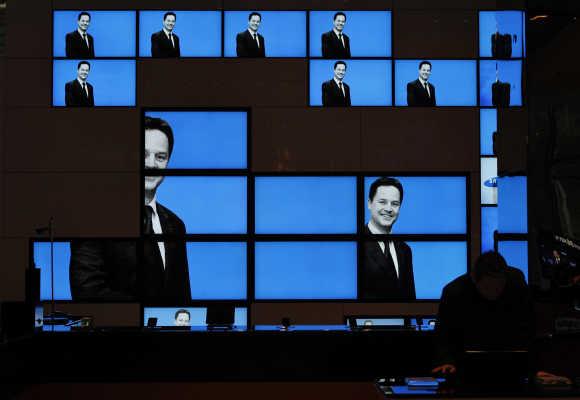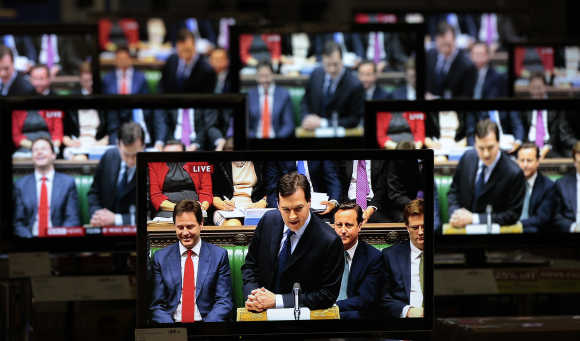Photographs: Bobby Yip/Reuters Pradeep S Mehta and Ashish Pherwani
On average, 35 per cent of prime time (7pm to 11pm) of news broadcasts is taken away by advertisements, against the hourly limit of 20 per cent prescribed in the regulations. In India, self-regulation is always at a premium, unless accompanied by a danda.
This is my considered experience having been a scholar-activist for nearly 30 years. The flood of advertising beyond a reasonable proportion, whether in the electronic medium or the print medium, has been debated for aeons without a fair resolution.
In the print medium, the unofficial norm has been 60 per cent news and 40 per cent advertising, but often the ratio goes berserk. Now that TV has become both a source of news and entertainment, the foray of advertisers in this sector has raised the ante of what should be a reasonable amount of advertising with which the consumer can be bombarded.
Unlike the print medium, the consumer cannot skip the ads except by hitting the mute button. And in most cases, when one tries and shifts to another similar channel, voila, more if not the same advertising again, and one waits patiently or does something else. I understand from industry sources that advertisers organise such collusive practice in association with compliant TV channels.
...
Should TV channels reduce ads?
Image: The maximum annual average has been found to be as high as 47.4 per cent.Photographs: Cathal McNaughton/Reuters
Indeed, this should be taken up by the Competition Commission of India. Moreover, a study on the duration of advertisements carried out in some news channels over the past four years reveals that, on average, 35 per cent of prime time (7pm to 11pm) of news broadcasts is taken away by advertisements, against the hourly limit of 20 per cent prescribed in the regulations.
The maximum annual average has been found to be as high as 47.4 per cent. This is apart from other types of innovative advertising, like using a part of the screen to carry static or moving captions, picture-in-picture, pop-up ads and so on.
Besides the over-abundance of advertisements in terms of duration, screen coverage and frequency, TV viewers also feel short-changed when the local multi-system operator, too, jumps in the fray with its own advertisements, which is a case of unjust enrichment.
Therefore, the Telecom Regulatory Authority of India's suo motu effort to regulate this growing and objectionable trend has set the cat among the pigeons.
TV broadcasters depend immensely on advertising revenues and are, thus, feeling the heat.
...
Should TV channels reduce ads?
Image: Regulations in respect of advertisements on TV are not new.Photographs: David Moir/Reuters
From questioning the need for interference in a "market-driven" field, they also allude to a possible increase in their rates for consumers and cite self-regulation as a better alternative in case the regulations are implemented.
Regulations in respect of advertisements on TV are not new - a number of jurisdictions across the world already have these in place. In Australia, an hourly cap on the minutes for ads is further bifurcated into peak hours and the rest. New Zealand, besides the hourly cap, also bans advertisements on Christmas, Good Friday, Easter and Sunday mornings.
Canada, in addition to the hourly caps, does not permit these on pay services. The UK, besides a fixed upper time limit, also lays down that the ads should not prejudice the integrity of the programme. Austria permits controlled time limits to ads but only on news and current affairs programmes.
The law in Denmark does not permit advertising interruption breaks during programmes and limits these in blocks between programmes and so on. That the TV advertising field needs regulation for the benefit of consumers or viewers is amply borne out by these examples.
In Philippines, TV advertising is self-regulated by individual broadcasters, which limits advertising to 18 minutes per hour to help promote public interest.
...
Regulations in respect of advertisements on TV are not new
Image: Rampant flouting of existing norms does not inspire confidence.Photographs: Jim Young/Reuters
For cable TV and other paid segments, the limit is 10 minutes an hour, provided that such advertisements are shown at the start and/or end of the programme.
In India, the rampant flouting of existing norms by broadcasters and advertisers does not inspire confidence in self-regulation, which inherently calls for a high degree of discipline, responsibility and accountability.
As far as an increase in rates is concerned, the regulator has argued that with the government setting the ball rolling on digitisation of the cable and satellite industry by December 2014, pay channels would not have to depend as much on advertising revenues as they now do.
But who knows, what will happen in the future, unless there is a danda.
The writer, Pradeep S Mehta, is Secretary General, CUTS International
Click NEXT to read the counterpoint...
Should TV channels reduce ads?
Image: There are around 150 pay TV channels in India today.Photographs: Kim Kyung-Hoon/Reuters
A fall in revenue will certainly impact not only production houses but also overall TV viewing time, since reduced content quality will result in reduced overall viewership"
There are around 150 pay TV channels in India today. These include all general entertainment and sports channels, and a few children's and news channels - that is, all the channels in which content is highly desired. Seventy to 75 per cent of the revenues of these channels come from ads, while the balance is derived from subscription and other revenues.
Currently, most channels air around 12 minutes of ads per hour. If this is to be reduced to six minutes, in accordance with the recent Telecom Regulatory Authority of India suggestion, one could expect to see one or more of the following developments:
(a) Ad rates can't be expected to double to make good the revenue dip for TV channels, so channels can certainly expect to witness a fall in their revenues.
If one looks at the financials of any listed TV broadcast company and reduces ad revenues even 25 per cent, most of these companies will incur losses. That is certainly a point that Trai needs to consider.
(b) Consequently, if ad revenues do fall, broadcasters will need to reduce their costs. Content cost is the key cost for most channels. Channel content cost, therefore, would need to be reduced.
...
Should TV channels reduce ads?
Image: Fall in revenue will impact not only production houses but also TV viewing time.Photographs: Brendan McDermid/Reuters
This means most shows with the highest viewership ratings like Saregamapa, Kaun Banega Crorepati, Indian Idol and so on, which cost as much as Rs 1.5 crore (Rs 15 million) per episode, will no longer be viable.
And let's not even get started on sporting events like cricket, where the cost of annual rights runs into hundreds of millions of dollars (and a single match can cost over Rs 30 crore [Rs 300 million]). So a fall in revenue will certainly impact not only production houses but also overall TV viewing time, since reduced content quality will result in reduced overall viewership.
(c) Given that most general entertainment, popular and sports channel inventory is 100 per cent-plus sold out currently, ad rates will increase substantially if the available inventory is halved.
More worryingly, the number of advertisers on TV will fall - all current advertisers can't afford these rates and first-time advertisers (who often use news channels to gain access to TV) will all but disappear.
For some TV-dependent advertiser categories, sales will drop because the same ad spend level will now get fewer ads and, therefore, fewer audiences for advertisers. This could have a medium-term impact on advertisers growth and expansion plans.
...
Should TV channels reduce ads?
Image: Digitisation will enable a consumer to buy only those channels they desire.Photographs: Chris Keane/Reuters
Increased rates on popular channels could cause advertisers to move their spends to other media, or less popular TV channels. And then, those media will have ad space and crowding issues. Should we then start regulating the ad:edit ratio of newspapers and radio stations, the font size of print ads and the number of internet pop-up ads as well?
The Trai note stresses that TV digitisation will result in increased subscription revenues for pay TV broadcasters to make good the resulting ad revenue decline. But digitisation has not yet happened on the ground, and it could take some years before the benefits begin to flow in to broadcasters.
Moreover, digitisation will enable a consumer to buy only those channels they desire, which will not only put added pressure on broadcasters to ensure content quality, but could also reduce subscribers for channels that are currently bundled into strong bouquets or packages.
As a viewer, I certainly understand and wholeheartedly support Trai's proposals on (i) reducing the number of ad breaks per hour; (ii) increasing the spacing between ad breaks #8743 (iii) equalising the ad volume with that of TV content.
However, as someone observing the media industry for over a decade, I also do understand that Indian TV is among the lowest priced TV services in the world, and advertising is required to fund its costs to keep it at that low price level for the consumer. Customers can also avail of ad-free content using TiVo, Mobile TV and the Internet.
Broadcasters, too, are completely aware that too many ads and ad breaks only hurt the viewership of their channels - each ad ensures that ad volumes are automatically controlled. So in conclusion, may I suggest that we let the market prevail? It generally works out best for all concerned.
The writer, Ashish Pherwani, is Associate Director, Advisory Services Ernst & Young Private Limited









article